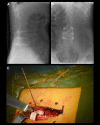Clinical Use of 3D Printing Guide Plate in Posterior Lumbar Pedicle Screw Fixation
- PMID: 26681388
- PMCID: PMC4687948
- DOI: 10.12659/msm.895597
Clinical Use of 3D Printing Guide Plate in Posterior Lumbar Pedicle Screw Fixation
Abstract
BACKGROUND This study aimed to evaluate the clinical efficacy of use of a 3D printing guide plate in posterior lumbar pedicle screw fixation. MATERIAL AND METHODS We enrolled 43 patients receiving posterior lumbar pedicle screw fixation. The experimental group underwent 3D printing guide plate-assisted posterior lumbar pedicle screw fixation, while the control group underwent traditional x-ray-assisted posterior lumbar pedicle screw fixation. After surgery, CT scanning was done to evaluate the accuracy of screw placement according to the Richter standard. RESULTS All patients were followed up for 1 month. The mean time of placement for each screw and the amount of hemorrhage was 4.9±2.1 min and 8.0±11.1 mL in the experimental group while 6.5±2.2 min and 59.9±13.0 mL in the control group, respectively, with significant differences (p<0.05). The fluoroscopy times of each screw placement was 0.5±0.4 in the experimental group, which was significantly lower than that in the control group 1.2±0.7 (p<0.05). The excellent and good screw placement rate was 100% in the experimental group and 98.4% in the control group, without any statistical difference (P>0.05). No obvious complications were reported in either group. CONCLUSIONS Compared with the traditional treatment methods, the intra-operative application of 3D printing guide plate can shorten the operation time and reduce the amount of hemorrhage. It can also reduce the fluoroscopy times compared with the traditional fluoroscopy, which cannot improve the accuracy rate of screw placement.
Figures



References
-
- Guarino J, Tennyson S, McCain G, et al. Rapid prototyping technology for surgeries of the pediatric spine and pelvis: benefits analysis. J Pediatr Orthop. 2007;27:955–60. - PubMed
-
- Lu S, Xu YQ, Lu WW, et al. A novel patient-specific navigational template for cervical pedicle screw placement. Spine (Phila Pa 1976) 2009;34:E959–66. - PubMed
MeSH terms
LinkOut - more resources
Full Text Sources

